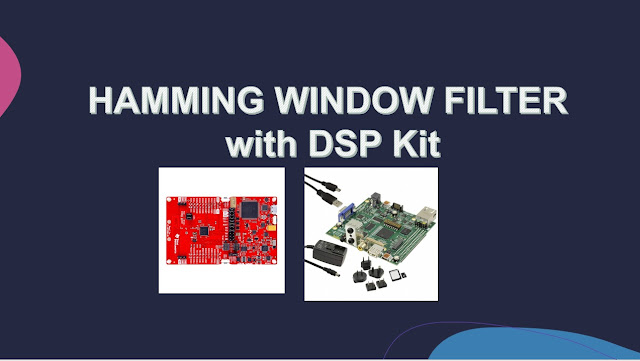To Study and design the Hamming window filter using the DSP TMS320F28335 in code composer studio.
SOFTWARE
REQUIRED:
Code Composer Studio (Version: 8.0)
HARDWARE REQUIRED:
DSP controller board (TMS320F28335), JTAG,
XDS100V2 board
THEORY:
The window
method for digital filter design is fast, convenient, and robust, but generally suboptimal.
It is easily understood in terms of the convolution
theorem for Fourier transforms, making it instructive to study after
the Fourier theorems and windows for spectrum analysis. It can be effectively combined with the
frequency sampling method.
The window method
consists of simply ``windowing'' a theoretically ideal filter impulse response h(n) by some suitably chosen window
function w(n).
By using
window filter, we design 5 types of filters:
1.
Rectangular 2. Bartlett 3. Hanning 4. Hamming 5. Blackman
Embedded
‘C’ CODE for LED Blinking:
#include<math.h>
#include<stdio.h>
float x[80];
double hd[11], W[11], h[11], y[90];
void main()
{
int i,j,f=50,fs=100;
double t,p;
double ts=0.001;
double w=2*3.1416*f;
double wc=2*3.1416*f/fs;
for(i=0;i<80;i++)
{
t=i*ts;
x[i]=1*sin(w*t)+.33*sin(3*w*t)+.2*sin(5*w*t)+.14*sin(7*w*t);
}
for(i=0;i<11;i++)
{
if(i==5)
hd[i]=wc/3.1416;
else
hd[i]=sin((i-5)*wc)/(3.1416*(i-5));
W[i]=0.54-0.46*cos(2*3.1416*i/(11-1));
h[i]=hd[i]*W[i];
}
for(i=0;i<80+11-1;i++)
{
y[i]=0;
for(j=0;j<11;j++)
{
if(i-j<0||i-j>=80)
p=0;
else
p=x[i-j];
y[i]=y[i]+h[j]*p;
}
}
}
WAVEFORMS:
Fig 1: Input signal waveform
Fig 2: FFT analysis of Input signal waveform
Fig 3: Desired filter waveform
Fig 5: Window function
waveform
Fig 6: FFT analysis of Window function waveform
Fig 7: final filter impulse
response waveform
Fig8: FFT analysis of final
filter impulse response waveform
Fig 9: Output waveform after
eliminating Harmonics
Fig 10: FFT analysis of Output
waveform after eliminating Harmonics
Conclusion: We Obtained the output response
of hamming window filter using the DSP TMS320F28335 in code composer studio and
the graphs plotted is displayed.

Post a Comment
Please do not enter any spam links in the comments...